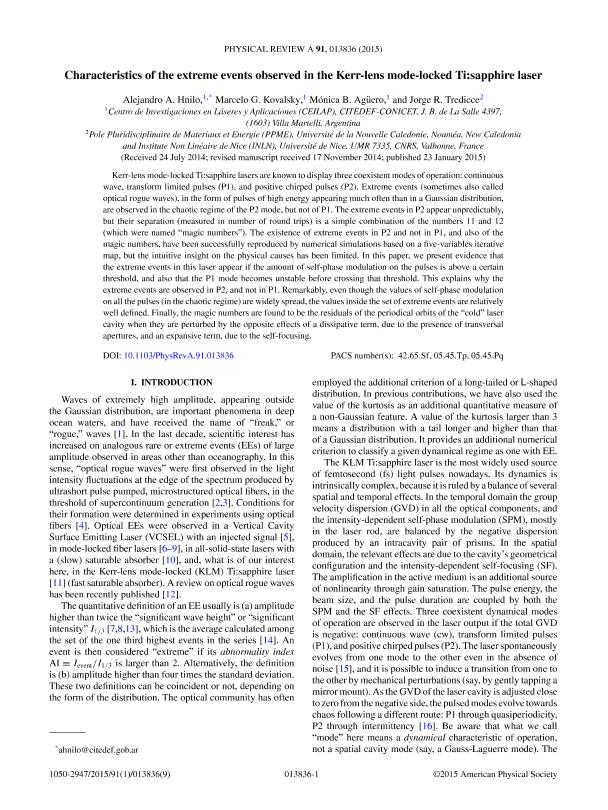Mostrar el registro sencillo del ítem
dc.contributor.author
Hnilo, Alejandro Andrés

dc.contributor.author
Kovalsky, Marcelo Gregorio

dc.contributor.author
Agüero, Mónica Beatriz

dc.contributor.author
Tredicce, Jorge Raul

dc.date.available
2019-08-20T18:56:20Z
dc.date.issued
2015-01
dc.identifier.citation
Hnilo, Alejandro Andrés; Kovalsky, Marcelo Gregorio; Agüero, Mónica Beatriz; Tredicce, Jorge Raul; Characteristics of the extreme events observed in the Kerr-lens mode-locked Ti:sapphire laser; American Physical Society; Physical Review A: Atomic, Molecular and Optical Physics; 91; 1; 1-2015; 13836-138369
dc.identifier.issn
1050-2947
dc.identifier.uri
http://hdl.handle.net/11336/81840
dc.description.abstract
Kerr-lens mode-locked Ti:sapphire lasers are known to display three coexistent modes of operation: continuous wave, transform limited pulses (P1), and positive chirped pulses (P2). Extreme events (sometimes also called optical rogue waves), in the form of pulses of high energy appearing much often than in a Gaussian distribution, are observed in the chaotic regime of the P2 mode, but not of P1. The extreme events in P2 appear unpredictably, but their separation (measured in number of round trips) is a simple combination of the numbers 11 and 12 (which were named "magic numbers"). The existence of extreme events in P2 and not in P1, and also of the magic numbers, have been successfully reproduced by numerical simulations based on a five-variables iterative map, but the intuitive insight on the physical causes has been limited. In this paper, we present evidence that the extreme events in this laser appear if the amount of self-phase modulation on the pulses is above a certain threshold, and also that the P1 mode becomes unstable before crossing that threshold. This explains why the extreme events are observed in P2, and not in P1. Remarkably, even though the values of self-phase modulation on all the pulses (in the chaotic regime) are widely spread, the values inside the set of extreme events are relatively well defined. Finally, the magic numbers are found to be the residuals of the periodical orbits of the "cold" laser cavity when they are perturbed by the opposite effects of a dissipative term, due to the presence of transversal apertures, and an expansive term, due to the self-focusing.
dc.format
application/pdf
dc.language.iso
eng
dc.publisher
American Physical Society

dc.rights
info:eu-repo/semantics/openAccess
dc.rights.uri
https://creativecommons.org/licenses/by-nc-sa/2.5/ar/
dc.subject
Dynamics
dc.subject
Non Linear Optics
dc.subject
Lasers
dc.subject
Ultrafast Pulses
dc.subject.classification
Óptica

dc.subject.classification
Ciencias Físicas

dc.subject.classification
CIENCIAS NATURALES Y EXACTAS

dc.title
Characteristics of the extreme events observed in the Kerr-lens mode-locked Ti:sapphire laser
dc.type
info:eu-repo/semantics/article
dc.type
info:ar-repo/semantics/artículo
dc.type
info:eu-repo/semantics/publishedVersion
dc.date.updated
2019-08-16T18:54:33Z
dc.journal.volume
91
dc.journal.number
1
dc.journal.pagination
13836-138369
dc.journal.pais
Estados Unidos

dc.journal.ciudad
Nueva York
dc.description.fil
Fil: Hnilo, Alejandro Andrés. Consejo Nacional de Investigaciones Científicas y Técnicas. Instituto de Investigaciones Científicas y Técnicas para la Defensa. Centro de Investigación en Láseres y Aplicaciones; Argentina
dc.description.fil
Fil: Kovalsky, Marcelo Gregorio. Consejo Nacional de Investigaciones Científicas y Técnicas. Instituto de Investigaciones Científicas y Técnicas para la Defensa. Centro de Investigación en Láseres y Aplicaciones; Argentina
dc.description.fil
Fil: Agüero, Mónica Beatriz. Consejo Nacional de Investigaciones Científicas y Técnicas. Instituto de Investigaciones Científicas y Técnicas para la Defensa. Centro de Investigación en Láseres y Aplicaciones; Argentina
dc.description.fil
Fil: Tredicce, Jorge Raul. Universite de la Nouvelle Caledonie; Francia. Centre National de la Recherche Scientifique; Francia. Consejo Nacional de Investigaciones Científicas y Técnicas; Argentina
dc.journal.title
Physical Review A: Atomic, Molecular and Optical Physics

dc.relation.alternativeid
info:eu-repo/semantics/altIdentifier/doi/https://dx.doi.org/10.1103/PhysRevA.91.013836
dc.relation.alternativeid
info:eu-repo/semantics/altIdentifier/url/https://journals.aps.org/pra/abstract/10.1103/PhysRevA.91.013836
Archivos asociados
